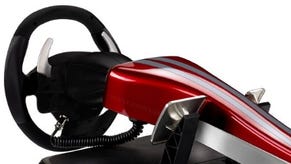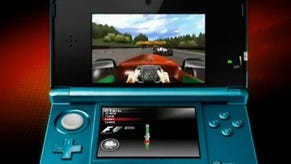Face-Off: F1 2011
A test of Vettel.
However, while we found last year's game to be pretty much like-for-like over a general run of play, the differences here in F1 2011 are far more dramatic. On the 360 at least, during gameplay there are very few drops in frame-rate and the renderer appears to be keeping up very well with the workload, meaning that there is little in the way of screen tearing. It's only really during the start of races - where all 24 cars are closely bunched up - where we see the otherwise solid 30FPS update being compromised. So, the overall impression we get is that the gameplay on the 360 is generally very smooth indeed, often closely mimicking that of a locked 30FPS experience, but some occasionally heavier dips here and there.
On the flip-side, things aren't quite so solid on the PS3, where screen tearing and frame-rate drops are often readily apparent. Our analysis of gameplay shows a pretty big discrepancy between the two; mainly when there are many cars bunched together on screen and when there are lots of alpha-based effects being kicked up off the track. In these situations we see the PS3 struggle to maintain the target 30FPS without dropping frames or tearing - city tracks like Monaco or racing in 'heavy rain' weather conditions are the most problematic.
The good news where the tearing is concerned is that is that most of it is contained either at the top of the screen in the skybox area, or where the tarmac track is located, so it will go by largely un-noticed due to the similarity between frames - it's really hard to tell a torn frame from a clean one when the difference between the two is minimal in these situations, although there are points where the heavy nature of the tearing can result in a highly visible screen wobble. While this does nothing to affect controller response, it does serve to briefly distract you when racing.
The drops in frame-rate have more of an impact on the gameplay, with the reduction in smoothness seemingly dulling controller response and thus affecting feedback between the player and the game. The smaller dips that occur quite regularly aren't really a problem as they don't really affect your ability to make precise movements when turning your car. It's only when the smoothness takes a sharp and prolonged dive to the mid-twenties and below that it becomes an issue. Additionally, there is also an intermittent juddering effect during both races and cut-scenes; a telling sign that a large number of frames are being dropped in quick succession at various points.
It's worth pointing out that F1 2011 is still a playable release on the PS3, although the experience you get during racing is definitely an inconsistent one - perhaps more so for intermediate players in which constantly jostling for position against surrounding cars tends to bring out the worst in the engine. In comparison, the 360 game offers up a higher degree of reliability in how it performs, with deviations from the 30FPS target being an exception rather than the rule.
Although enlightening, results of gameplay analysis can generally be quite variable at times, down to the unpredictable nature of the rendering load and the ever changing action on screen. However, replays offer up a more accurate measure of performance in a like-for-like manner, with both the track-side scenery and amount of cars on screen mostly matching up across both consoles.
As the replay video suggests, while the 360 versions maintains its lead through these sequences neither game fares particularly well, with there being large amount of visible tearing on screen and some pretty hefty frame-rate drops. There is a commonality between the results here and with our analysis of the gameplay: smoke and weather effects, in combination with a large number of cars on screen causes a significant performance hit on the PS3, so much so that the drop in frame-rate sometimes lead to the worst affected scenes almost appearing like a juddering, slowed down video. Generally speaking, both versions drop frames and tear at similar points, though the results are usually worse on the PS3, with things evening out in scenes which put less stress on the engine.
Overall, it's fair to say that the Xbox 360 delivers the most consistent experience of the two. While replays still suffer from some unsightly performance drops, the gameplay is a largely smooth affair with little compromise to the expertly handled racing action. In comparison, the PS3 release comes as something of a disappointment in this regard, though not without some merit - the underlying improvements to the AI, car handling and driving physics are all present and it's still clearly a worthwhile game.


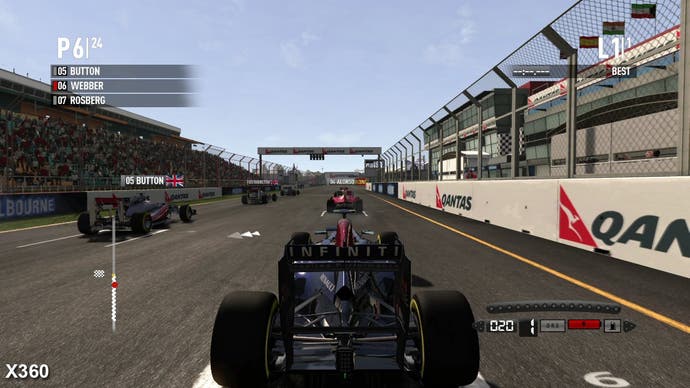
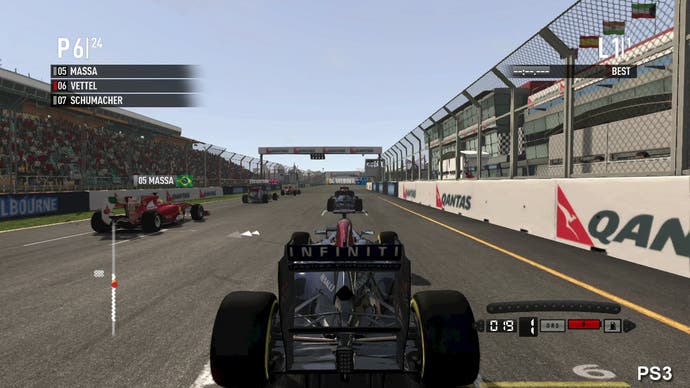
It's not all bad for the PlayStation 3 game. As we mentioned earlier, texture detail and filtering is like-for like, with any differences in the artwork being down to the MLAA implementation subduing fine details - though very mildly to be honest - while the water surfaces reflections, rendered in a lower resolution and with less precision in F1 2010, are identical across both platforms this time around, with the puddles on the water accumulating in the same places on the track.
Some compromises in other areas still remain. For example, the smoke and water splashes kicked up by the car tyres seem to be pared back on the PS3, making things appear a little sparse in these conditions - these effects appear fuller and more intense on the 360, the water especially engulfing the scene when there are many cars bunched together on the track. Texture LODs also seem to be a little worse on the PS3, with transitions occurring slightly closer to the camera. This accounts for the slight reduction in the clarity of the artwork situated in the distance.

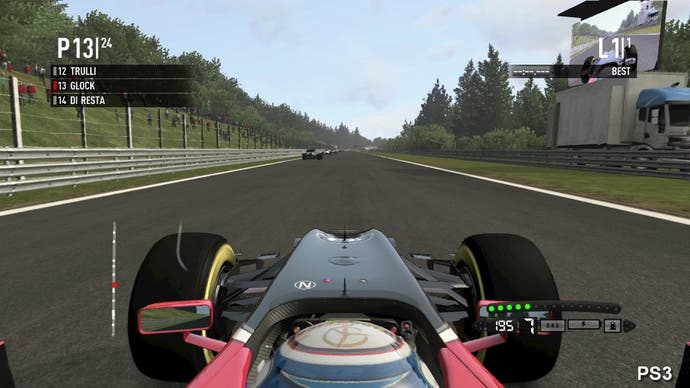


The Shanghai track also brings about an interesting difference: some light sources are missing on the PS3, most notably around the barriers of the course, which can be seen in the shots below. Why this is happening at all isn't so clear. Perhaps we are simply seeing a rendering bug, although this anomaly is absent from both 360 and PC builds.
As with F1 2010 Codemasters once again pares back the level of motion blur on offer significantly in comparison to the DiRT and GRID games. The idea here being to create a more subdued look grounded in reality: a look more fitting for a racing simulation. The effect is still present on the 360, albeit subtly, whilst it appears to be completely absent on the PS3. On 360, there's still a sense that the blur contributes to the overall look of the game, making motion seem ever so slightly smoother in certain circumstances - such as when turning corners quickly - but its impact is relatively minor.
